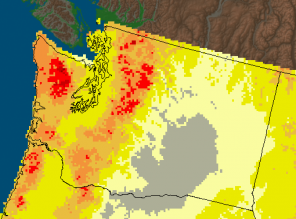
Reports University of Washington meteorologist Cliff Mass: “[F]or those that love weather records, it is official. The August-September precipitation at Seattle-Tacoma Airport (of .03 inches) was the driest in the 65-year record at that location.” On average, August (Seattle’s second-driest month after July) would bring about an inch of rain, September, an inch and a half. October averages almost three and a half inches of what’s known colloquially as “the wet stuff.”
UPDATE: Mass looks into the existence of Summer SAD.
As of today, the National Weather Service’s Seattle bureau has a 7-day forecast that’s nothing but blue skies and Sol-shine. In other areas this news might be greeted with cheers and flip-flops, but in Seattle, there’s an undercurrent of anxiety. The Stranger‘s Bethany Jean Clement sounds like she might be misting herself as she writes, “for those of us who grew up here, this long, long spell of no rain is just creepy.”

In fact, it’s not just creepy–it’s dangerous, as Red Flag warnings indicating extreme fire danger have been flying for Western Washington, whose outdoorsy population is not used to the foliage bursting into wildfires. 150 acres burned near Shelton yesterday and overnight.
“We have not seen wildfire conditions this bad in October in a lifetime,” said Commissioner of Public Lands Peter Goldmark. The DNR suggests you avoid doing anything that generates sparks or heat. No parking your car in dry grass. No target shooting. Certainly no campfires.
East of Seattle, the citizens of Leavenworth are preparing for Oktoberfest and celebrating clearer skies and cleaner air–eastern Washington’s air quality has been hard hit by the summer’s wildfires. It was a hazy summer all over.
And what about the skiing? The winter will in theory be of the El Niño persuasion, though not that forcefully, and KING 5’s Jeff Renner admits that “typically that means a warmer, drier winter than average.” Cliff Mass is holding out hope, you sense, that it’s a neutral winter instead, neither El Niño nor La Niña, “since the biggest of the big events (floods, windstorms, even snowstorms) tend to occur in neutral years.”